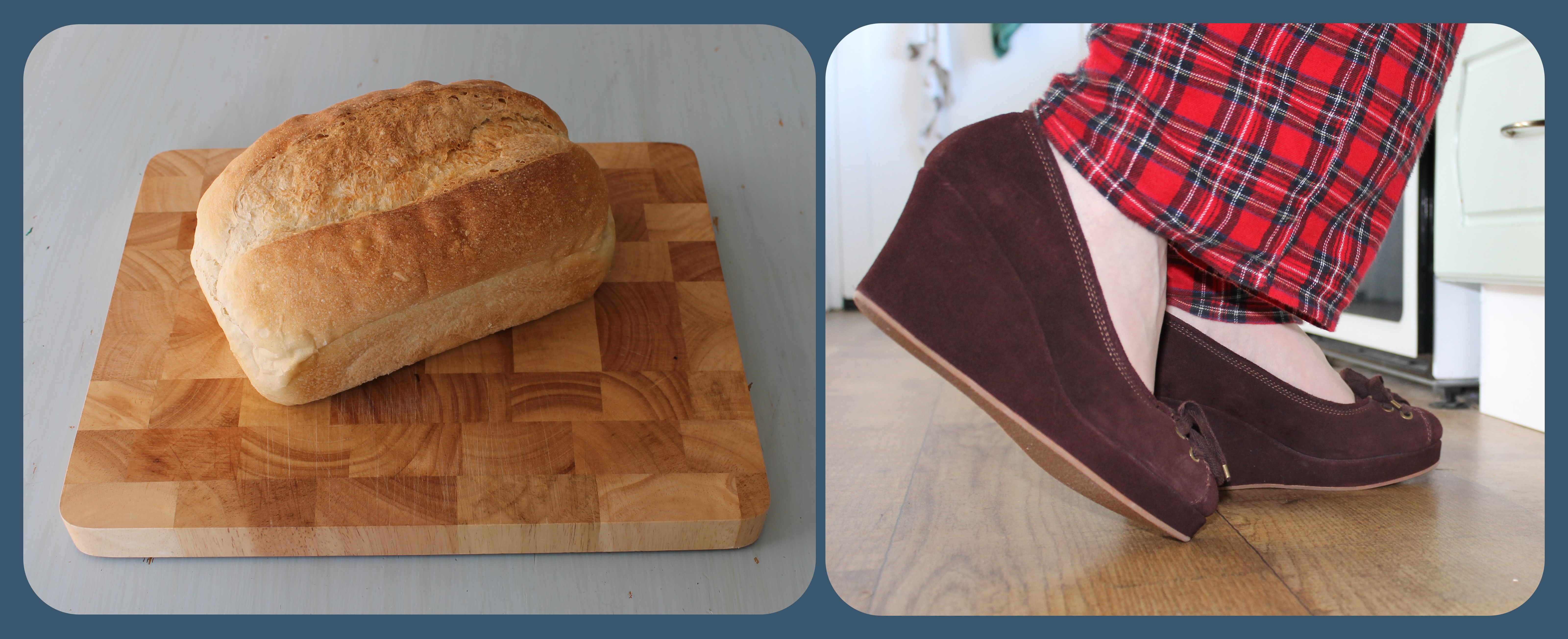
A couple of years ago I began making my own bread by hand and it has now become an at least twice-weekly event. People often ask, “Isn’t it really hard to do?” and the answer is no.
However, I have recently made an addition to my bread making routine which I haven’t yet come across in any books; high-heels.
At 5’3” I know I am not actually that short but it is just short enough to find standard kitchen worktops just a couple of inches too high.
To give bread a good knead it is better to be able to exert some downward force and I found that I was always standing on tip toe whilst doing so. Making bread can be a bit of a work-out in itself but doing so at the same time as standing on your toes makes the experience rather more wobbly.
After joking many times that I should keep a pair of heels in the kitchen – not only for bread making but also to access the shelves in the cupboards (sadly just the lower shelves, the top ones are still out of bounds, heeled shoes not withstanding) – I eventually did it one day.
Now I can be found wearing my wedges whenever making bread – regardless of what else I may be dressed in. That’s right, I may be in my pyjamas getting an early loaf started, or in my comfies, having a relaxed day, but whenever there is the making of bread – there will also be my heels.
Making bread at home is something my mum always did. There is a running joke in our family that you could build houses with mum’s bread as it is dense and solid in the way that only true wholemeal bread can be. But, we loved it as children and we love it now.
It is the thing that will always be comfort to us: mummy’s bread – preferably with marmite.
It was the go-to food when we were ill, when we were running in from an after-school sports session and needed something to fill the gap before tea – and as we got older, it was the thing consumed late at night, giggling and in overtly hushed tones when we had staggered in from the pub.
I was terribly bullied at school and I remember on occasions when I came home in a not so good state, mum would either have or get some bread on the go and would encourage me to take out some anger and frustration by pummelling the dough. This was a great distraction for me at the time, if only for a short while, but now I believe that bread making, along with all cooking and baking, is best done not with anger but in a happy state of mind.
Many times, food made when ill, tired or angry has just not turned out well at all and I do believe the mood in which you make something can have an impact on how it ends up.
I am very lucky now to be able to make my bread overlooking our garden and often get treated to a good deal of bird watching – my current favourite visitors being the pair of wrens that I have seen many times hopping about the pots on our patio.
As I am kneading the dough I often reflect on how I have my mother’s hands and how she in turn had her mother’s. They are not pretty hands, they are not slender or delicate and never have prettily painted nails. (I try sometimes but invariably I have chipped, imprinted or got something stuck in the varnish within minutes of it going on.) But, they are working hands. Caring hands.
For my three sisters and I, our mum and our grandma; hands are for doing and creating, they are for caring for people, digging the garden, creating fun with paint, glue, needle and thread, they are for living. And I love them.
I haven’t always loved them, as a teenager I used to look in a kind of intrigued envy at the delicate gesticulations of people with slender fingers, small wrists and the tiniest of rings that could slip easily onto any finger. They were fascinating to me and I used to long for the same – usually when desperately trying to get a ring off a reddening giant knuckle that I had dared hope would fit.
But as happens so often, as you get older you begin to appreciate things in a different way. I can still feel the touch of my mum’s hand on my forehead when she comforted me as a child when ill in bed. The skin may have been rough, but the love conveyed could not have been more gentle. And I hope that my hands give as much care and love as they did.
When I come in from the garden with my fingernails full of mud and my skin prickled and scraped, I know that they have done a job and one that will either result in something yummy to eat or be a beautiful thing to look at.
And when I cook and bake I will always be reminded of my grand-ma and cooking with her in her kitchen with the old Formica table and how there was always porridge cake (my family’s name for flapjack) to be eaten and copious jars of fruit bottled in the pantry having been picked from the garden.
Hands and bread making – just two things that have been passed on along the female generations of my family – but, I think I am the first to introduce kitchen heels into baking. I wonder if it will catch on.